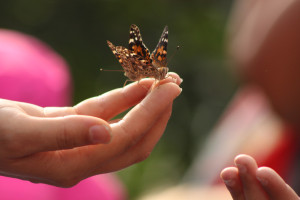In a scorching Indian summer day in 1886, three to four thousand people climbed the steep goat trails to the summit of Yerba Buena Island, the 100-acre natural island between San Francisco and the East Bay. A San Francisco newspaperman remarked on the contrast of the women’s colorful skirts against the “barren wasteland” of grass and “dark withered shrubs.” Local dignitaries–including Adolph Sutro, General Mariano Vallejo, and poets Joaquin Miller and Ina Coolbrith– planted the first ceremonial trees, and then 12 trees were planted to represent the cultures of the world: olive and cork from Spain, mulberry from France, and wattle acacia and eucalyptus from Australia. Finally, thousands of school-children planted seedlings in the form of a cross.
Today the island is covered with trees and nonnative plants (along with houses), but botanists have been pleased to discover remnants of native vegetation beneath the eucalyptus, European grasses, French broom, and cotoneaster. That’s why a Habitat Management Plan is being prepared to help safeguard native habitats when Yerba Buena and its man-made companion, Treasure Island, are transferred from the U.S. Navy to the City and County of San Francisco. A draft of the plan is expected in April 2009.
Yerba Buena has been closed to the public since the mid-1800s, so botanist Michael Wood had no idea what he’d find when he did a botanical study in 1995. His plant list was the first known for the island and includes 105 natives. Some of the botanical treasures are dune gilia, Dutchman’s pipe (used by pipevine swallowtail butterflies), yellow bush lupine (also seen on the eastern side of Angel Island), and fiesta flower, a small blue-purple flower that once lived in San Francisco and San Mateo counties but hasn’t been seen locally for years (except at Henry Coe State Park near Gilroy).
Ruth Gravanis is an environmental activist who has long been involved in the planning for both Yerba Buena and Treasure islands. She’s participated in work parties organized by Nature in the City, and as a member of the San Francisco Commission on the Environment, she works to ensure that the island’s native plants are protected during redevelopment. At Clipper Cove on the island’s north side, she points out several coyote bushes that have been freed from the mob rule of French broom and fennel. She isn’t happy to see that the yellow-flowered exotic oxalis still lords over a section of the beach. “It’s a huge pain in the butt,” she says. “And you can quote me on that.” Nevertheless, the hillside above Clipper Cove supports native ferns, lizard tail, arroyo willows, wild rye, and blue elderberry.
The proposed redevelopment plan for both islands includes up to 200 new homes on Yerba Buena, as well as 300 acres of parks and open space. The habitat plan should be completed in June 2009. Public comments are encouraged. For updates and meeting notices, email Michael.Tymoff@sfgov.org.

.jpg)


-300x221.jpg)